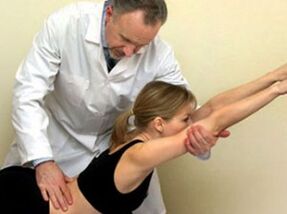There are probably few people who, after 30-35 years, do not regularly complain of discomfort and pain in various areas of the back, as well as temporary numbness in the legs or arms.Such manifestations may indicate the possibility of developing osteochondrosis.This disease is quite common and occurs when the cartilage tissue of the spine begins to change under the influence of various reasons and loses its mobility and flexibility.This disease can develop in any part of the spine, but most often affects the discs between the vertebrae.If you move little or sit at work for a long time, the likelihood of developing osteochondrosis is very high.

People usually only pay attention to the symptoms and other changes associated with this disease in the second half of life.
The likelihood of developing the disease increases significantly if:
- You already know what age-related changes are;
- They had back injuries (no matter when);
- They had to undergo excessive physical exertion;
- You are constantly in stressful situations;
- Their work involves strong vibrations.
And spinal osteochondrosis has also become significantly “younger” in recent decades.
An early onset of the disease is possible if:
- the person has poor physical fitness or poor posture;
- a person eats prematurely or incorrectly;
- suffers from flat feet or a curvature of the spine;
- the person has bad habits – overeating or smoking.
In addition, the load on the spine also increases during pregnancy, so it often becomes the cause of osteochondrosis in girls and women.
Danger of osteochondrosis
How to deal with osteochondrosis?In the early stages of osteochondrosis (first or second), its symptoms may be mild or not bother the person at all.This is dangerous because advanced osteochondrosis, in addition to discomfort and pain, can also lead to complications in the form of serious diseases such as kyphosis, radiculitis or intervertebral hernia.
What to do if you have osteochondrosis?- Treat, because if osteochondrosis is detected in the early stages, you can get rid of it completely.
Modern methods of treating osteochondrosis
In the complete treatment of spinal osteochondrosis, two methods are used: complex therapy (conservative) and surgical intervention.
Complex therapy (conservative)

Therapy for osteochondrosis consists of a whole range of medicinal and additional methods.This therapy is prescribed if you are in the early stages of this disease.
Treatment of grade 1 osteochondrosis is carried out by:
- use of drug therapy;
- local and general massage;
- a set of physiotherapy exercises;
- the use of reflexology and the entire variety of physiotherapeutic methods.
Treatment of grade 2 osteochondrosis additionally requires the use of the spinal traction method.Spinal traction is performed with a load selected individually for each patient.Special devices are used for this.The spinal traction procedure not only relieves acute pain, but also restores the correct position of your spine and increases the intervertebral space.
Medication methods
- the use of various anti-inflammatory and analgesic agents;
- the use of modern drugs that restore cartilage tissue.
Methods of drug use during drug treatment:
- all kinds of external rubs and compresses.
- oral administration of tablets and capsules.
- Procedures such as infusions and injections.
As a result of drug treatment of osteochondrosis, pain is relieved, acute inflammation is relieved, muscle tissue is gradually relaxed, some affected cartilage is restored, blood supply and metabolic processes are improved.Such treatment of the disease is necessarily prescribed in case of exacerbation of the disease.
Additional methods

- specially developed therapeutic diet;
- massage and self-massage;
- physiotherapy methods;
- manual therapy;
- light underwater hydromassage;
- pulling (traction therapy);
- Acupuncture;
- traditional medicine;
- meditative relaxation;
- spas;
- a set of physiotherapy exercises;
- Working with a psychotherapist.
Surgical treatment (surgical)
In the later stages of the disease (third and fourth phases), surgical treatment is used when other proven treatment methods no longer help.Treatment of later stages is more complex, since the underlying disease itself is already accompanied by other diseases of the spine - radiculitis, hernias.The indication for surgical intervention is the occurrence of an intervertebral hernia.Sometimes it is even necessary to completely remove the affected hard drive.
Treatment of grade 4 osteochondrosis requires extremely complex surgery with a high risk of damage to the nerves of the spinal cord.Therefore, surgical treatment is carried out extremely rarely if attempts to cure a patient with osteochondrosis in other ways have not helped.
How long does osteochondrosis treatment take?
How to quickly cure osteochondrosis?This depends on the presence of pronounced age-related changes, the variability in the expression of symptoms and the variety of treatment methods used.The patient himself can also actively contribute to recovery by carefully following the instructions of his treating therapist.
Treatment of grade 1 osteochondrosis usually lasts one to four months.In the fourth degree after surgery, the recovery period can last from one to one and a half years.Treatment also depends on the patient's personality.He must be positive, persistent, strong-willed and highly motivated.
Treatment of various types of osteochondrosis
Osteochondrosis is distinguished by the location of the spinal lesion (its location).The localization of osteochondrosis can be:
- cervical;
- Breast;
- lumbar spine;
- widespread.
Main complaints:
- with cervical localization – a person regularly feels pain in the shoulders and arms, as well as headaches.Due to the compression of the arteries, there are occasional noises in the ears, colored spots and “swimmers” in front of the eyes, and slight dizziness.
- with chest localization - a person complains of pain of the type: “a stake was inserted into the chest”, “shots” in the heart, stomach or lungs.
- with lumbosacral localization – a person complains of severe pain in the lumbar spine, which can spread to the sacrum, groin and even legs.Some patients experience numbness in the leg muscles.
- If the localization is extensive, complaints about a wide variety of symptoms occur.In this form of the disease, a person complains of several types of symptoms at the same time.
How to treat cervical osteochondrosis?
Treatment methods for neck osteochondrosis today are:
- painkillers, anti-inflammatory drugs, antispasmodics;
- Stimulants for tissue restoration, anti-inflammatory gels, ointments for external use;
- manual therapy;
- exercise therapy;
- hirudotherapy;
- reflexology;
- traditional medicine;
- surgical intervention if the case is particularly serious.
How to treat thoracic osteochondrosis?
Measures to treat breast type:
- painkillers and anti-inflammatory medications;
- Acupuncture;
- manual influence;
- vacuum therapy;
- physiotherapy;
- cupping massage;
- traditional medicine;
- Moxotherapy (warming with wormwood cigars).
Exercise therapy for breast diseases is used not only as an addition to general therapy, but also to form a muscle corset;Among other things, exercise therapy prevents possible relapses.
How to treat lumbosacral osteochondrosis?

Therapy at different stages is conservative and surgical.
Conservative treatment of lumbosacral osteochondrosis in the early stages includes:
- drug therapy, in some cases hormones;
- manual influence;
- general health supplements;
- reflexology (acupuncture);
- lower back massage;
- traditional medicine;
- Hirudotherapy (leeches);
- Movement therapy.
Stage 4 lumbosacral osteochondrosis usually requires surgical intervention.
How to treat common osteochondrosis?
Treatment of common osteochondrosis is carried out:
- Prescribing appropriate drug treatment;
- Application of all types of manual therapy;
- physiotherapy exercises;
- use of acupuncture methods;
- various methods of physiotherapy;
- Development of a special diet.
Any form of spinal osteochondrosis requires surgical intervention in only ten percent of cases.The operation can be prescribed for patients with complications, but also if the patient has turned to a specialist for treatment late.If the diagnosis is made in a timely manner and you have already started therapy, it will be nice if traditional methods of treating this disease are added to the traditional methods.Traditional methods have proven themselves effective in the treatment of any type of osteochondrosis.
Treatment with traditional methods
Folk remedies for this disease are used only together with drug treatment.They aim to reduce inflammation, pain and discomfort.Decide for yourself how you want to treat osteochondrosis of the spine - with various traditional medicines or only medical methods.

Popular folk remedies:
- taking tonic pine baths;
- Applying copper plates and coins to the back.
- Compresses with added aloe juice;
- massage with honey, honey packs;
- fresh decoctions of herbs: oregano, hop cones and chamomile;St. John's wort, dandelion and burdock roots;
- applying horseradish leaves to a sore spot;
- applying rye or potato cake to the sore spot;
- sunflower herbal tea;
- red elderberry tincture;
- Burdock compresses.
As you begin treating your osteochondrosis, you may notice that your pain only increases.This is a completely expected reaction of your body to unusual influences.Soon this pain will stop completely.The best way to treat osteochondrosis is to combine conservative therapy with postoperative rehabilitation in specialized centers.
How can a person get rid of osteochondrosis?
Here are the three most common questions that concern patients with osteochondrosis:
- How to get rid of osteochondrosis?
- How to quickly cure osteochondrosis?
- Where is the best place to treat osteochondrosis?
Doctors answer these questions differently, because the speed of recovery depends not only on the form of the disease, but also on the timeliness of treatment by the patient.
Experts can only guarantee complete healing for the first and second stages of the disease.Therefore, you should contact a therapist immediately, even if you have only noticed some of the symptoms.Although all modern methods of treating osteochondrosis are quite effective, doctors consider the combination of a number of traditional methods with constant training on stationary rehabilitation equipment to be the most effective therapy.This treatment helps to completely restore the muscle corset and forget about the disease for a long time.
Why shouldn't a patient with osteochondrosis be treated at home?
- It is not recommended to treat a patient with osteochondrosis at home, since the lack of a special orthopedic bed, physiotherapy equipment and special exercise equipment can greatly reduce the effectiveness of treatment;
- Not every patient can constantly adhere to his daily routine, take prescribed medications on time, follow a diet or undergo all medical procedures.Additionally, many patients require regular reminders to continue treatment.
- At home, it is difficult to follow the proper diet recommended by a nutritionist.
This leads to the conclusion: you can try to treat osteochondrosis at home, largely resorting to traditional methods of treatment.However, the best solution would still be to visit a specialized clinic or hospital for this profile, constantly being under the supervision of a highly qualified therapist.





















